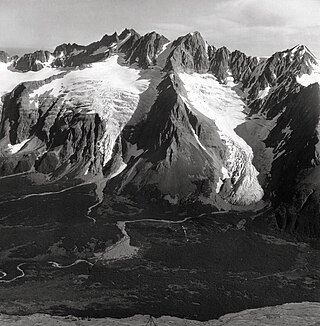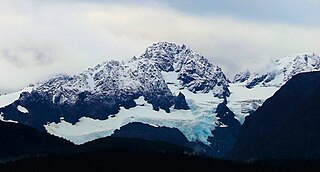
Cecil Rhode Mountain is a 4,400-foot (1,341 m) mountain summit located in the Kenai Mountains, on the Kenai Peninsula in the state of Alaska. The mountain is situated in Chugach National Forest, 50 mi (80 km) south of Anchorage, and 1.7 mi (3 km) south of Cooper Landing, Alaska. This peak is shown on maps as Cooper Benchmark, the northernmost peak on a ridge which includes Stetson Benchmark, and Peak 4593.

Mount Carmack is a prominent 6,808-foot-elevation (2,075-meter) mountain summit located in the Boundary Ranges of the Coast Mountains, in the U.S. state of Alaska. The peak is situated 7 mi (11 km) north-northeast of Skagway, and 3.5 mi (6 km) south of Mount Cleveland, on land managed by Tongass National Forest. As the highpoint on the divide between the Taiya River and the Skagway River, precipitation runoff from the mountain drains east into the Skagway River and west into Taiya River, both of which empty into Taiya Inlet. Although modest in elevation, relief is significant since Mount Carmack rises 6,800 feet above the Taiya valley in less than 2 mi (3 km), and 5,800 feet above Skagway valley in about 2 miles. Mount Carmack has a lower subsidiary summit, elevation 6,621 ft (2,020 m), about 0.5 mi (1 km) to the northeast of the true summit. The USGS topographic map has this lower northeast peak labelled as Mount Carmack.

Tipton Peak is a 10,941-foot elevation (3,335 m) summit located in Elko County, Nevada, United States.

Spanish Fork Peak is a 10,192-foot elevation (3,107 m) mountain summit located in Utah County, Utah, United States.

Icy Peak is a 4,550-foot-elevation (1,390-meter) mountain summit in Alaska, United States.

Mount Stepo is a 3,828-foot-elevation (1,167-meter) mountain summit in Alaska.

Kupreanof Mountain is a 2,440-foot-elevation (744-meter) summit in Alaska.

Eickelberg Peak is a 3,648-foot-elevation (1,112-meter) summit in Alaska, United States.

West Saint Peak is a 3,337-foot-elevation (1,017-meter) summit in Alaska.

Mount Emmerich is a 6,877-foot-elevation (2,096-meter) mountain summit in Alaska.

Santa Ana Peak is a 4,764-foot-elevation (1,452-meter) mountain summit in Alaska, United States.

Mount Sumdum is a 6,666-foot-elevation (2,032-meter) mountain summit in Alaska, United States.

Nun Mountain is a 4,329-foot-elevation (1,319-meter) mountain summit in Alaska.

Mount Ada is a 4,528-foot-elevation (1,380-meter) mountain summit in Alaska, United States.

Gullied Peak is a 3,350-foot (1,021 m) mountain summit in the US state of Alaska.

Sugarloaf Mountain is an 11,051-foot-elevation (3,368-meter) summit on the boundary that Salt Lake County shares with Utah County, in Utah, United States.

Clayton Peak, also known unofficially as Mount Majestic, is a 10,721-foot-elevation (3,268-meter) summit on the boundary that Salt Lake County shares with Wasatch County, in Utah, United States.

Saddle Peak is a 9,159-foot-elevation (2,792-meter) mountain summit in Gallatin County, Montana, United States.

Heney Peak is a 3,156-foot-elevation (962-meter) mountain summit in Alaska, United States. The peak is located 2.5 miles (4.0 km) south of Cordova, and it is the highest peak of the eight-miles-long group of mountains called the Heney Range south of the town. This mountain is part of the Chugach Mountains and is set on land managed by Chugach National Forest. Precipitation runoff from the mountain drains west to Orca Inlet via Heney and Hartney creeks, whereas the east slope drains to Mountain Slough, then the Gulf of Alaska shortly thereafter. Topographic relief is significant as the summit rises 3,150 feet (960 m) above Mountain Slough in 1.5 miles (2.4 km). The mountain was named in 1927 by the U.S. Forest Service for Michael James Heney (1864–1910), builder of the nearby Copper River and Northwestern Railway. The toponym was officially adopted in 1928 by the U.S. Board on Geographic Names.

The Sisters are mountain summits in Alaska, United States.





















